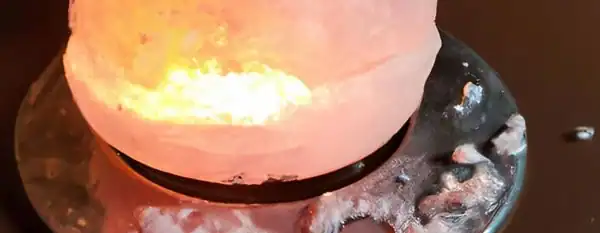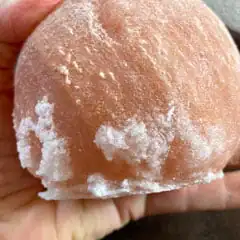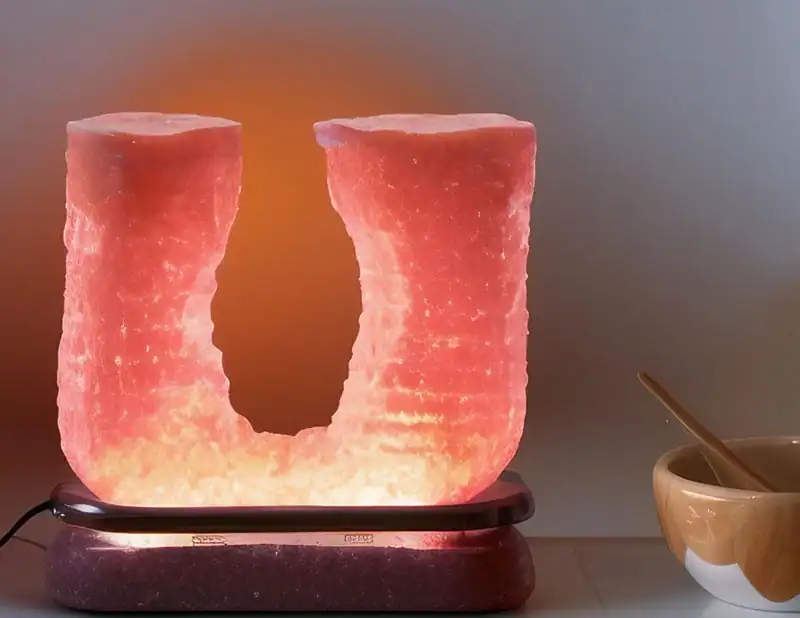Anyone that has used salt while cooking a meal knows that salt will disappear almost as soon as it hits the pan, so it would stand to reason that your Himalayan salt lamp might also melt … I mean, light bulbs produce heat, so do salt lamps melt?
While heat from the bulb may cause the salt to release some moisture, salt lamps do not melt. People sometimes observe the salt recrystallizing, and in extreme cases small pieces of salt might flake off.
In this article I thought I’d dive into some of the reasons why a Himalayan salt lamp will recrystallize, or in a few cases flake or crack. I’ll look into some of the effects the bulb does actually have on the lamp and some tips and tricks to keep your salt lamp in good shape for years to come!

How Does The Heat From the Bulb Inside the Lamp Affect the Salt?
The heat from the bulb inside a Himalayan salt lamp can have an effect on the salt over time. The heat from the bulb causes the salt to release moisture, and this process can cause the salt to lose its structural integrity.
When a salt lamp is at room temperature, without the bulb turned on, the salt will naturally absorb a little bit of moisture from the air in the room. You can’t really see it doing anything and the salt will remain dry – but salt is a desiccant so it just does that naturally. When you turn the lamp on, it heats up a bit and then the salt can’t hold quite as many water molecules, so it will release them. Once again, it is unlikely that you will see a difference in your lamp’s appearance – this is microscopic.
What you will notice over time, is that cycles of humidity, or cycles of using the lamp, will cause the salt on the surface to recrystallize. The crystals tend to be a lot less dense than the original salt that was packed together in an underground mine underneath the Himalayan mountains.

You can see the surface recrystallization of salt in this picture – the salt forms fuzzy or frothy looking crystals that have a lot of air in between, so it makes the salt look white instead of pink.
Overall, the heat from the bulb inside the lamp can have an impact on the salt, but with proper care and use, it is possible to maintain the integrity and shape of the lamp.
Can the Heat From the Bulb Cause the Salt to Dissolve or Melt?
The salt in Himalayan salt lamps are naturally hygroscopic, which means it absorbs water from the air. When the salt is heated by the bulb, the heat causes the absorbed water to evaporate, leading to the salt recrystallizing.
Himalayan salt has a high melting point, about 800*C / 1500*F, so temperatures in your home or from lighting the lamp will not come close to reaching that temperature. Incandescent bulbs that are used in salt lamps have an average surface temperature range of 150*F to 250*F. Salt is affected far more by water than by heat.
As the salt recrystallizes in response to humidity, it is possible that it may do it in such a way or location that it can cause salt to flake off of the surface of the salt lamp. In extreme cases, it is possible that the lamp could shed larger flakes or lose structural integrity.
How Can I Ensure That My Himalayan Salt Lamp Does Not Lose Its Shape?
To ensure that your Himalayan salt lamp does not lose its shape from recrystallization, use proper care techniques and use of the lamp as suggested by the manufacturer. In addition to their tips, here are a few additional tips for maintaining the shape of your salt lamp:
- Placement – Avoid placing the lamp in direct sunlight or in a very humid environment. Excessive heat or humidity can cause the salt to dissolve more quickly. Basements and attics aren’t likely ideal places for usage or storage. Salt Lamps are also not recommended for outdoor usage – if you do use it on the patio occasionally, be sure to store it indoors until it is next in use. For more on salt lamp placement, see Creating A Soothing Space: 13 Places To Put A Salt Lamp.
- Bulbs – Use a bulb with the correct wattage for your lamp. Using a bulb with too high of a wattage can cause the salt to dissolve more quickly.
- Clean – Dust and dirt can accumulate on the surface of the salt, leading to it losing its luster and potentially causing the salt to flake more quickly. Wipe the surface of the lamp with a dry cloth to remove dust and dirt.
- Handling – Handle the lamp carefully. Avoid knocking or bumping the lamp, as this can cause the salt to break or crumble. Since salt is a natural material with a crystal structure, it is possible that invisible flaws or ‘sheer lines’ exist. Bumping the lamp could cause a larger piece of salt to break off of the block.
- Store – If not using your lamp, store it in a cool, dry place.
By following these tips, you can help to ensure that your Himalayan salt lamp retains its shape and remains in good condition.
Is It Okay To Keep A Himalayan Salt Lamp In The Bathroom?
The bathroom can be a pleasant place for a salt lamp since it provides a soft glow suitable enough to see at night but not so bright that it blinds you.
I know I just made a point in the above sections about keeping your salt lamps out of humid places, namely attics and basements, so why is it okay to keep one in the bathroom, a location that likely has a bit of extra humidity when compared to other rooms of the house? Because they can be really nice in a bathroom as a nightlight or for setting a spa-type environment. Just realize that the humidity in that room may shorten the life of the lamp. Fortunately, lamps are fairly affordable, so you can decide if it is worth it.
It is important to be aware of a few considerations when placing a Himalayan salt lamp in the bathroom:
- Avoid placing the lamp in direct contact with water. The salt in the lamp can absorb moisture from the air, but it is not designed to be submerged in water or exposed to high levels of humidity.
- Avoid placing the lamp within reach of anyone sitting or standing in water (sufficient distance from the tub or shower).
- Use a bulb with the correct wattage for your lamp. Using a bulb with too high of a wattage can cause the salt to dissolve more quickly and potentially break or crumble. For more about selecting a bulb for your lamp, see Salt Lamps 101: How To Choose The Right Salt Lamp Bulb.
- Keep the lamp clean. Dust and dirt can accumulate on the surface of the salt, leading to it losing its luster and potentially causing the salt to dissolve more quickly and break or crumble. For more about cleaning and maintaining salt lamps, see The Surprising Truth About Dirt on Himalayan Salt Lamps.
By following these considerations, you can use a Himalayan salt lamp in the bathroom without any problems.
Final Thoughts
Luckily, Himalayan salt lamps don’t really require that much care, and they don’t melt. Keep them indoors, out of direct sunlight, and use them according to manufacturer’s recommendations and you’ll be able to enjoy them for many years.







